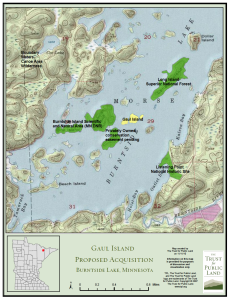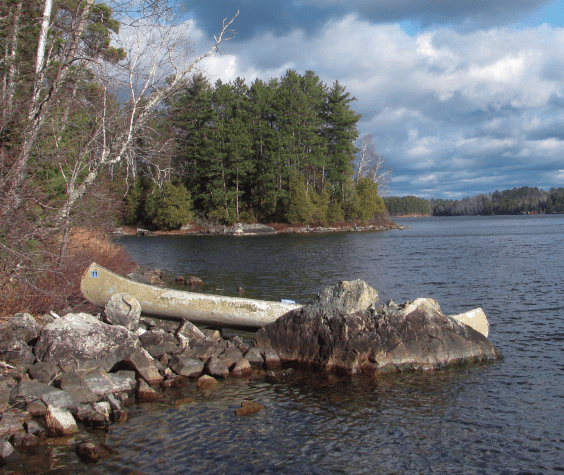How a collaborative effort is transferring private land to public stewardship.
By Alissa Johnson
In the summer of 2010, the Trust for Public Land (TPL) received an inquiry from the Listening Point Foundation. The owners of a 15-acre island across from Listening Point had notified the Foundation that they intended to sell their property.
Gaul Island sits in the heart of Burntside Lake’s western arm, a gateway to the Boundary Waters Canoe Area Wilderness (BWCAW) and home to a series of permanently protected islands, including 43-acre Long Island acquired by TPL in 2004 and now a part of the Superior National Forest. Add to that its proximity to Listening Point, now on the National Register of Historic Places, and the fact that zoning would allow four building sites, and development had the potential to dramatically change the area.

Discussions and negotiations with the landowners proceeded, and by November it became clear that an appraisal of the island needed to be conducted in order to meet the year-end deadline set by the landowners. Shaun Hamilton, TPL director of the Northwoods Initiative, remembers that posed a problem. The boats had already been taken out of Burntside Lake, and if they didn’t meet the deadline the island would be put on the market. He made a few calls to see if he could secure a boat. As luck would have it, Sigurd Olson’s very own canoe was available.
On a cold, blustery day Hamilton launched the canoe from Listening Point in 20-mile-an-hour winds. Waves rocked the canoe, and the appraiser looked a little green. But it was worth it to brave the weather. Protecting the island would create a bridge between Long Island and two Minnesota Scientific and Natural Areas used for research, Pine and Snellman Islands. It would add to critical shoreline and wildlife habitat and protect future recreational opportunities. Like Long Island, it might fill a need for recreation outside of the BWCAW.
“Part of the need is for near wilderness recreational experiences. Not everyone can go into the Boundary Waters and spend a week, and that has been one of the priorities for the Superior National Forest to provide those opportunities,” Hamilton said.
Or, it could fill research needs like Pine and Snellman islands. However the land could be preserved, TPL’s mission and structure allowed it to act faster to acquire land than the Forest Service or other federal and state agencies. While partners like the Forest Service, the State and Listening Point all see the value in protecting the island, they wouldn’t have been able to act within the required timeline. So TPL filled in, acting as the catalyst to eventually transfer Gaul Island to public ownership and permanent public steward. TPL used funds from its Northwoods Land Protection Fund to purchase the island by December of 2010.
“The Northwoods Land Protection Fund is a revolving land protection fund that allows us to acquire at-risk properties and get them taken off the market and hold them until public funding can be acquired,” he said.
Additional expenses related to acquisition and holding will be covered by donations from organizations like the Quetico Superior Foundation until the island can be transferred to public ownership.

When that will happen and what public ownership will look like is yet to be determined, but Hamilton said there is interest among state and federal conservation partners and TPL is working on facilitating conversations to explore options. Ideally, he said, Gaul Island would be added to the Superior National Forest or the Burntside Islands State Natural Area. But he’s comfortable with the fact that it might take some time to get there.
“Originally, when looking at the island we knew there would be no assurances, but we decided to acquire the land knowing it could be a number of years before public money is available for acquisition,” Hamilton said, adding, “We knew this may be the opportunity to converge and bring these groups together and get everyone looking at a larger picture.”
It would be an innovative approach to land preservation, but one that Hamilton has seen work in western states. It’s also one worth pursuing for an island located in a pristine lake with the cultural and historical significance of Burntside. And already, the collaboration between the landowners, the Listening Point Foundation and TPL is praiseworthy. Hamilton hopes to build on that foundation by weaving “together a larger partnership of public, private, and nonprofit conservation efforts in a pretty unique landscape and island ecosystem.”
Find out more at:
www.tpl.org
www.listeningpointfoundation.org
This article appeared in the Summer 2012 edition of Wilderness News

